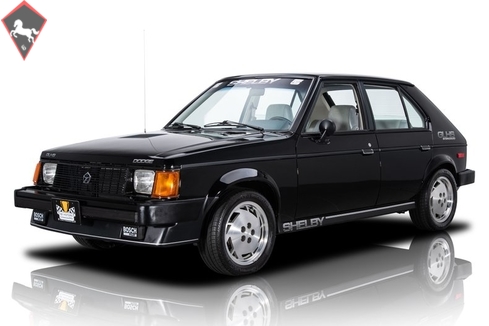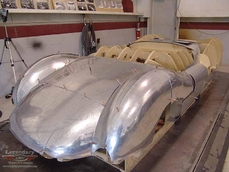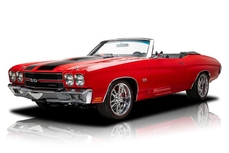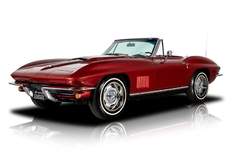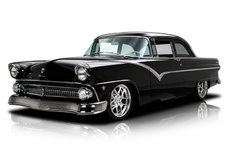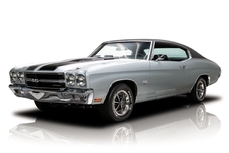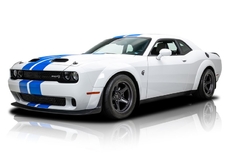Shelby GLHS Omni GLHS Turbo 1986
Allgemeine Beschreibung :
The early 1980s could quite possibly be considered the dawn of compact performance. The good ole days of fire-breathing muscle cars were long gone, but enthusiasts still thrived. And a new generation of gearheads latched onto small, easy to own hatchbacks like this exclusive Shelby GLHS. Number 477 of only 500 Omnis upfitted to 'Goes Like Hell S'more' form by Shelby American, this impressive classic was a rare car even when new, and it certainly makes no qualms about catering directly to enthusiasts. Because of that, most of these featherweights were whipped to an early grave by three or four different owners. And, as any '80s car fan will tell you, finding a GLHS that's in good condition has become beyond difficult. Well, until now… This fully documented, 3-owner survivor is an exceptional example of just that!
FULL OWNERSHIP HISTORY
By 1986, Dodge's honest Omni had become an established player in America's re-invigorated compact car market. Eccentric gearheads knew if you wanted to look cool, you bought a GLH. If you wanted to look cool and go fast, you bought a GLHT. And if you wanted to look cool, go fast and slay some serious sports car titans, you bought a GLHS. Averaging just over 419 miles per year, this pint-size MoPar appears to have rarely seen anything other than sunshine and warm summer days. In fact, the first 18 miles of its life was under the meticulous care of its original owner who, after purchasing this Shelby from Canoga Park, California's Dependable Dodge, would keep it for roughly eight years. The second owner was quick to make a deal after spotting the car in Autotrader, and promptly relocated it to a garage in Moorpark, California. Fast forward thirteen years and this Dodge's third owners found their new muse on Autotrader online, sporting roughly 8,800 miles. And in mid-2019, this highly original head turner found its way here to RK Motors Charlotte wearing a still paltry 13,839 miles.
With low window sills, 2.5-box proportions and 100% original paint, this Shelby is a model of '80s cool. At the front of the car, an aggressive air dam frames bright Bosch Pilot fog lamps beneath a monochromatic bumper and a body-matched, Pentastar-branded grille. At the top of that grille, a vented hood reflects 'DODGE' and 'GLHS' decals opposite Shelby-branded glass that's framed in Satin Black trim. At the base of that glass, a planar, GLHS-branded profile hangs black door handles and matte trim spears between stylish mirrors and aggressive, Shelby-branded rockers. And at the back of that profile, a second monochromatic bumper frames clean taillights, a full array of hatch decals and a small Center High Mount Stop Lamp.
TURBO II BEFORE TURBO II WAS COOL
Naturally, in their seemingly never ending effort to improve the Omni, Shelby did not overlook the car's mechanicals. Using many of the components that would eventually form the basis of Chrysler's forthcoming Turbo II powerplant, the firm created what would predictably be known as the Turbo I. Massaging Chrysler's stalwart 2.2 liter began with quite a bit of top-end work. A Turbo II air box was bolted in front of a larger, Turbo II throttle body and a modified intake that was designed to complement the car's larger turbocharger. A spliced and reconfigured wiring harness linked a GLHS-spec sloped boost curve logic module with Turbo II fuel rails and Turbo II fuel injectors. And tuned exhaust manifolds joined a better radiator, a better intercooler and better fan assemblies to manage power-robbing heat. Consequently, the Shelby powerplant created 175 horsepower and 175 lb./ft. of torque on its way to a 6.5 second 0-60 time and a top speed of 135 MPH. Put into perspective, that meant the GLHS was a very formidable car. Prized for both its ability to dominate track competition and outrun many of the day's best performance icons, this Dodge bested cars like the Camaro, the Trans Am, Ford's Mustang and even many Corvettes.
NOT JUST LOOKS
The GLHS came standard with an A525 5-speed that feeds the front wheels. Holding that tossable drivetrain off the ground is a Shelby-massaged suspension that makes excellent use of adjustable Koni shocks. Those shocks are led by lucid power steering. Stops come courtesy of power front disc and rear drum brakes. At the center of that chassis, an original single-pipe exhaust system snakes spent gases through a Chrysler-branded muffler. At the corners of that chassis, machined wheels spin 205/50ZR15 Michelin Pilot Exaltos. And, fully sorted and factory-spec, this hatch is a clean, first class survivor that's ready to hit the road as soon as it rolls out of our showroom!
1980S COZY
Between the doors, a sedate tri-tone cockpit shows hardly any signs of wear. Cloth-lined seats keep passengers as comfortable for quick blasts of speed as they do during long road trips. Front and center, a pliable dash founds factory air conditioning beneath factory telemetry that's complete with a correct 135 MPH speedometer overlay. At the base of the dash, a boxy console frames a short shifter that's finished with a leather-wrapped Momo knob. A modern Kenwood head unit bumps crisp Polk Audio speakers. The driver twists a leather-wrapped Izumi steering wheel. And naturally, there's a prominent Shelby plaque that lists this GLHS's sequential production number.
Whenever we post unique, low-mileage survivors, they sell almost immediately. A whole generation of buyers grew up with these endearing hatchbacks. And since they're becoming increasingly scarce, the good ones get snapped up as quickly as they hit the market. If you're an enthusiast who likes to put their hardware on the road, few classics deliver this blend of exclusivity and practicality. And with only 13,839 original miles, this is one MoPar that'll have you smiling every time you slide behind its wheel!
----------
HIGHLIGHTS
* Fully documented, 3-owner Dodge Shelby GLHS survivor that's traveled only 13,839 miles * Number 477 of only 500 produced * 2.2 liter Turbo I 4-cylinder * A525 5-speed manual transaxle * Factory air conditioning * Power steering * Power front disc and rear drum brakes * Shelby-tuned suspension * Modern audio system * Original Window Sticker * Bill of Sale and Odometer Disclosure Statement from original owner * Autotrader ads from 1994 and 2007 (when the car transitioned to owners two and three) * Service records * All RK Motors vehicles receive a comprehensive, multi-point inspection * We can arrange shipment of your purchase anywhere in the world
https://www.rkmotors.com/vehicles/3476/1986-dodge-shelby-glhs-turbo
1986 Shelby GLHS Omni GLHS Turbo is listed verkauft on ClassicDigest in Charlotte by Donald Berard for $31900.
Fakten der Auto
Karosserietyp : Auto Marke : Shelby Modell : GLHS Omni Ausführung : GLHS Turbo Hubraum : 0.0 Modelljahr : 1986 Lage : Charlotte
Verkauft
Angaben Zum Verkäufer
Verkauft
People who viewed this Shelby GLHS Omni also viewed similar Shelby listed at ClassicDigest
Other cars listed for sale by this dealer
über Shelby
Carroll Shelby, eine legendäre Figur in der Automobilwelt, hatte einen bemerkenswerten Weg vom erfolgreichen Rennfahrer zum renommierten Sportwagenhersteller in den Vereinigten Staaten. Seine Geschichte ist voller Erfolge, Innovationen und ikonischer Autos, die einen unauslöschlichen Eindruck in der Branche hinterlassen haben.Frühe Jahre und Rennkarriere:
Carroll Shelby wurde 1923 in Texas geboren. Während des Zweiten Weltkriegs verfolgte er zunächst eine Karriere als Pilot, entdeckte aber nach dem Krieg seine wahre Leidenschaft im Rennsport. Shelby wurde in den 1950er Jahren ein erfolgreicher Rennfahrer und nahm an verschiedenen Veranstaltungen teil, darunter der Formel 1, Langstreckenrennen und den berühmten 24 Stunden von Le Mans.
Shelby Cobras – ikonische Sportwagen:
Carroll Shelbys entscheidender Moment als Hersteller kam mit der Entwicklung des Shelby Cobra, einem legendären amerikanischen Sportwagen. Die Cobra entstand aus der Fusion eines britischen AC-Ace-Chassis und eines Ford-V8-Motors und schuf ein leichtes Hochleistungsauto, das sowohl auf der Rennstrecke als auch auf der Straße dominierte. Zu den wichtigsten Modellen gehören:
Shelby Cobra 260 (1962): Die erste Version mit einem 260 Kubikzoll (4,2 l) V8-Motor.
Shelby Cobra 289 (1963–1965): Spätere Versionen mit einem 289-Kubikzoll-V8-Motor (4,7 l), einschließlich der Cobras mit Wettbewerbsspezifikation, die für ihre Rennfähigkeiten bekannt sind.
Shelby Cobra 427 (1965–1967): Die stärkste Version mit einem 427 Kubikzoll (7,0 l) V8-Motor, bekannt für seine rohe Kraft und Leistung.
Ford-Partnerschaft – Shelby Mustangs:
Shelbys Partnerschaft mit Ford führte zur Entwicklung der legendären Shelby Mustangs. Das bemerkenswerteste Modell ist:
Shelby GT350 (1965–1969): Basierend auf dem Ford Mustang wurde der GT350 von Shelby American modifiziert und zeichnete sich durch verbesserte Leistung, Handling und unverwechselbares Design aus.
Weitere bemerkenswerte Modelle und Erfolge:
Neben den Cobras und Mustangs leistete Shelby noch weitere bedeutende Beiträge:
Shelby Daytona Coupé: Dieses Auto wurde für den Sieg gegen Ferrari im internationalen GT-Rennsport entwickelt und war 1965 das erste amerikanische Auto, das die FIA GT-Weltmeisterschaft gewann.
Shelby Series 1: Ende der 1990er Jahre eingeführt, war dies Shelbys moderne Interpretation eines Hochleistungssportwagens.
Der Ford GT40 spielt in Carroll Shelbys Erzählung eine zentrale Rolle, insbesondere in Bezug auf seine Verbindung zu Ford und seinen bedeutenden Beitrag zum Erfolg des Autos.
Die Entwicklung des Ford GT40:
Fords Herausforderung:
Anfang der 1960er Jahre versuchte Henry Ford II, Ferrari zu erwerben, doch die Verhandlungen scheiterten. Dies bestärkte Ford in seiner Entschlossenheit, Ferrari beim prestigeträchtigen Langstreckenrennen 24 Stunden von Le Mans zu schlagen, das Ferrari mehrere Jahre lang dominiert hatte.
Zusammenarbeit mit Shelby:
Ford wandte sich an Carroll Shelby und schätzte dessen Rennsportkompetenz und Erfolgsbilanz. Shelby wurde damit beauftragt, das GT40-Projekt zu leiten und daraus einen konkurrenzfähigen Rennwagen zu machen, der Ferraris Vormachtstellung herausfordern konnte.
Entwicklung und Triumph:
Unter Shelbys Anleitung wurde der Ford GT40 einer gründlichen Entwicklung unterzogen, um anfängliche Designfehler und Leistungsprobleme zu beheben. Es wurden mehrere Iterationen erstellt:
Frühe Versuche: Die ersten Versionen des GT40 hatten Probleme mit der Zuverlässigkeit und dem Handling, was 1964 zu enttäuschenden Ergebnissen in Le Mans führte.
GT40 Mark II: Shelbys Team hat entscheidende Verbesserungen vorgenommen. Der Mark II, ausgestattet mit einem leistungsstarken V8-Motor, verbesserter Aerodynamik und verfeinerter Technik, wurde äußerst konkurrenzfähig.
Le-Mans-Sieg:
1966 errang der Ford GT40 Mark II einen historischen Sieg bei den 24 Stunden von Le Mans, wobei der von Shelby trainierte Fahrer Ken Miles das Rennen anführte. Dies war der erste Sieg eines amerikanischen Herstellers in Le Mans und brach damit die Dominanz von Ferrari.
Anhaltenden Erfolg:
Der GT40 dominierte weiterhin und gewann in den folgenden drei Jahren (1966–1969) Le Mans, sicherte sich seinen Platz in der Renngeschichte und festigte Fords Ruf als Kraft im internationalen Motorsport.
Shelbys Beitrag zum GT40-Erfolg:
Obwohl Carroll Shelby nicht direkt an der Entwicklung des GT40 beteiligt war, trugen seine Erfahrung im Rennsport und seine Fähigkeit, ein Team aus talentierten Ingenieuren, Mechanikern und Fahrern zusammenzustellen und zu leiten, entscheidend zur Verbesserung der Leistung des Autos bei. Sein Einfluss trug dazu bei, technische Probleme anzugehen, das Fahrverhalten des Autos zu verfeinern und Renntaktiken zu entwickeln, was maßgeblich zum Erfolg des GT40 auf der Rennstrecke beitrug.
Vermächtnis und Auswirkungen:
Die Siege des Ford GT40 in Le Mans unter Shelbys Führung gehören nach wie vor zu den ikonischsten Errungenschaften in der Geschichte des Motorsports. Der Erfolg des Autos festigte Shelbys Ruf als Automobilvisionär und stärkte seine Partnerschaft mit Ford weiter.
Carroll Shelbys Beteiligung am GT40-Projekt stellte seine Fähigkeit unter Beweis, ein schwieriges Projekt in eine Maschine zu verwandeln, die die Meisterschaft gewann, und fügte seiner illustren Karriere in der Automobilwelt ein weiteres bemerkenswertes Kapitel hinzu.
